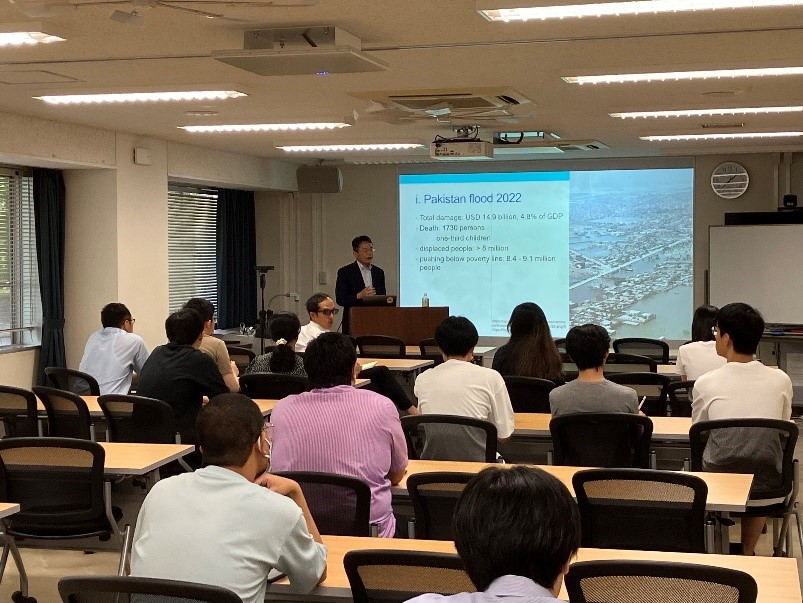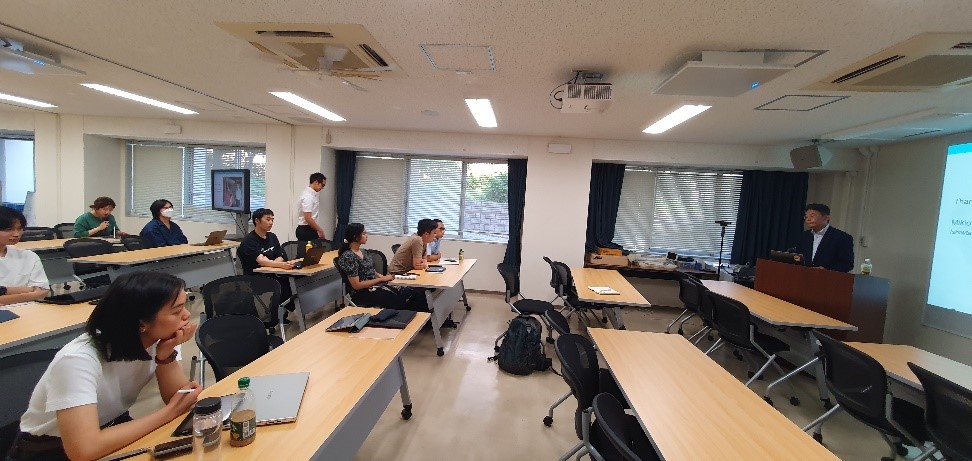Special Lecture:
Inclusive Disaster Risk Reduction and Recovery: Issues and Challenges
Guest Speaker: Dr. Mikio Ishiwatari
Date: 7th June 2023
Currently working as a senior advisor at the Japan International Cooperation Agency (JICA), a visiting professor at The University of Tokyo, and the board director of Japan Water Forum, we are very pleased to have invited Dr. Mikio Ishiwatari to share his experience and knowledge regarding inclusive disaster risk reduction and recovery.
What is happening in the world?
During the first part of the lecture, Dr. Ishiwatari briefly introduced different disasters that are happening in the world. Each disaster causes damage by cascading effects. When a disaster happens, it will be followed by a series of events. For example, during a flood in Pakistan in 2022, the damage included the loss of livestock, which further affected the agriculture sector and the people’s economic situation.
Dr. Ishiwatari sharing a flood case study in Pakistan
Development/Growth and Disaster
In the recent 20 years, earthquake is the disaster that caused the most casualties, while storms bring the most economic damage. It was interesting to see how different countries suffer different types of damage from disasters. Studies have shown that higher-income countries experience more severe economic damage while lower-income countries have a higher death toll. In the case of Nepal, deforestation is currently a serious issue as wood is used for fuel, commercial, and other purposes. As a result, flood is frequently happening and is accompanied by landslides, destruction of houses, and economic damage. Unfortunately, challenges remain in breaking the cycle between disaster, environment, and poverty.
Issues of Inclusiveness
The main topic of today’s lecture is inclusive disaster risk reduction and recovery. At this point, it is important to define the vulnerable groups, and who should be included in the disaster management plan. Women, the poor, people living in remote areas, people with disabilities, the elderly, and people with different ethnicity and religious backgrounds are considered vulnerable. According to Dr. Ishiwatari, JICA is now focusing on gender issues in disaster management. From previous disaster experiences, studies have pointed out that the needs of women are insufficient at evacuation shelters. This issue can be traced back to the participation of women during the disaster planning stage. In the case of Japan, the percentage of female members in the prefectural disaster management council is very low. Efforts have been done after the experience of the Great East Japan Earthquake, increasing from 3.4% on average to now over 10%. Indeed, participation is one of the keys to inclusiveness in disaster management. If there is more participation by women in the planning stage, the disaster management council can have a better knowledge of the needs of women during emergency situations.
Dr. Ishiwatari also pointed out the different vulnerable groups in different cases of disasters in Japan. During the Hanshin-Awaji Earthquake in 1995, the vulnerable groups were mostly low-income households and older age groups. One notable point from the death toll disaggregated by gender and age is that the age group of 20 to 24 years old has the highest death toll among the age groups below 50. This is due to the fact that students that are mostly from this age group cannot afford good houses, and therefore were killed by collapsing buildings.
During the Great East Japan Earthquake in 2011, two-thirds of the casualties were the elderly. Besides that, statistics have shown that people with disabilities have a death ratio of 2 times more than people without disabilities. Gender inequality issues were also mentioned and reflected after the disaster. As 95% of the evacuation shelter manager heads were males, it is reported that women evacuees were experiencing privacy and security issues in the evacuation center. Another case study mentioned during the lecture was the flood in Mabi, Okayama. From that disaster experience, people found out that the evacuation centers were not equipped to handle special needs like medicines, people needing special dietary care, and people with disabilities. Many of the families with disabled children chose to stay at home or go to their relative’s houses instead of going to an evacuation center as they could not receive the special care they need.
JICA’s Activities
Currently, JICA and Japan Overseas Cooperation Volunteers (JOCV) are actively engaged in relief activities for gender and diversity-sensitive shelter operation and management. They integrate the voices and needs of vulnerable groups and provided various supports, ranging from the dispatch of medical relief team, and supporting women’s groups, to teaching skills like handcrafting, recycling, and composting to the women’s community. One example of the recovery activities from Typhoon Yolanda in 2013 is mentioned. JICA helped with the reconstruction of livelihoods through the processing of agricultural and fishery products by women’s groups. After the food processing, there were sales promotions to help to improve the economic situation of the affected people. Lastly, there were also projects for the reconstruction of daycare centers to help with the situation of women and children.
Due to time limitations, Dr. Ishiwatari was not able to finish all parts of the presentation slides he prepared, but we certainly had a fruitful session with him. At the end of the lecture, he emphasized that participation is the key to inclusiveness and it is important that people of vulnerable groups participate in disaster planning in order to improve their situation and reduce their vulnerability during disasters.
Q&A session after the lecture
Lastly, we would like to thank Dr. Ishiwatari for sparing your valuable time to share with us your experiences working on inclusive disaster risk reduction and recovery. It was a wonderful opportunity for us to have learned more about disaster inclusiveness and had a great discussion session.

